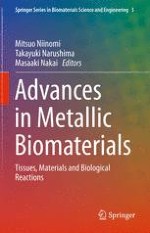This book reviews fundamental advances in the use of metallic biomaterials to reconstruct hard tissues and blood vessels. It also covers the latest advances in representative metallic biomaterials, such as stainless steels, Co-Cr alloys, titanium and its alloys, zirconium, tantalum and niobium based alloys. In addition, the latest findings on corrosion, cytotoxic and allergic problems caused by metallic biomaterials are introduced. The book offers a valuable reference source for researchers, graduate students and clinicians working in the fields of materials, surgery, dentistry, and mechanics.
Mitsuo Niinomi, PhD, D.D.Sc., is a Professor at the Institute for Materials Research, Tohoku University, Japan.
Takayuki Narushima, PhD, is a Professor at the Department of Materials Processing, Tohoku University, Japan.
Masaaki Nakai, PhD, is an Associate Professor at the Institute for Materials Research, Tohoku University, Japan.
